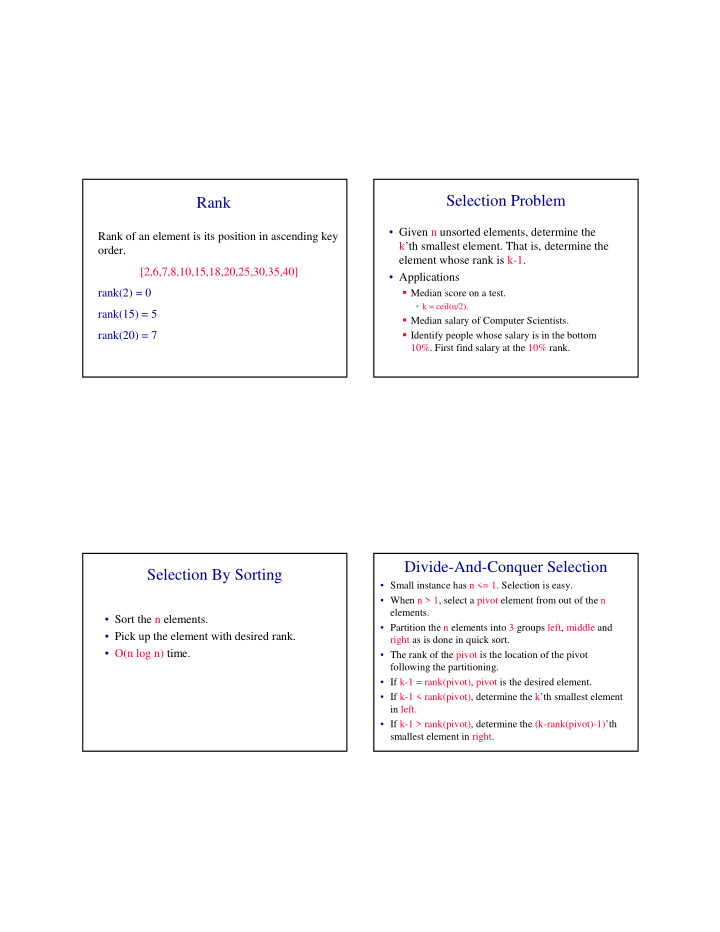



Selection Problem Rank • Given n unsorted elements, determine the Rank of an element is its position in ascending key k’th smallest element. That is, determine the order. element whose rank is k-1. [2,6,7,8,10,15,18,20,25,30,35,40] • Applications rank(2) = 0 � Median score on a test. • k = ceil(n/2). rank(15) = 5 � Median salary of Computer Scientists. rank(20) = 7 � Identify people whose salary is in the bottom 10%. First find salary at the 10% rank. Divide-And-Conquer Selection Selection By Sorting • Small instance has n <= 1. Selection is easy. • When n > 1, select a pivot element from out of the n elements. • Sort the n elements. • Partition the n elements into 3 groups left, middle and • Pick up the element with desired rank. right as is done in quick sort. • O(n log n) time. • The rank of the pivot is the location of the pivot following the partitioning. • If k-1 = rank(pivot), pivot is the desired element. • If k-1 < rank(pivot), determine the k’th smallest element in left. • If k-1 > rank(pivot), determine the (k-rank(pivot)-1)’th smallest element in right.
D&C Selection Example D&C Selection Example a 1 2 1 0 2 4 3 10 11 9 7 8 Find kth element of: • If k = 6 (k-1 = rank(pivot)), pivot is the a 3 2 8 0 11 10 1 2 9 7 1 element we seek. • If k < 6 (k-1 < rank(pivot)), find k’th Use 3 as the pivot and partition. smallest element in left partition. a 1 2 1 0 2 4 3 10 11 9 7 8 • If k > 6 (k-1 > rank(pivot)), find (k- rank(pivot)-1)’th smallest element in right rank(pivot) = 5. So pivot is the 6’th partition. smallest element. Time Complexity Closest Pair Of Points • Worst case arises when the partition to be searched always has all but the pivot. • Given n points in 2D, find the pair that are � O(n 2 ) closest. • Expected performance is O(n). • Worst case becomes O(n) when the pivot is chosen carefully. � Partition into n/9 groups with 9 elements each (last group may have a few more) � Find the median element in each group. � pivot is the median of the group medians. � This median is found using select recursively.
Applications Air Traffic Control • We plan to drill holes in a metal sheet. • If the holes are too close, the sheet will tear during • 3D -- Locations of airplanes flying in the drilling. neighborhood of a busy airport are known. • Verify that no two holes are closer than a • Want to be sure that no two planes get closer than threshold distance (e.g., holes are at least 1 inch a given threshold distance. apart). Simple Solution Divide-And-Conquer Solution • When n is small, use simple solution. • When n is large • For each of the n(n-1)/2 pairs of points, determine the distance between the points in � Divide the point set into two roughly equal parts A and B. the pair. � Determine the closest pair of points in A. • Determine the pair with the minimum � Determine the closest pair of points in B. distance. � Determine the closest pair of points such that one • O(n 2 ) time. point is in A and the other in B. � From the three closest pairs computed, select the one with least distance.
Example Example d 1 A B A B • Divide so that points in A have x-coordinate • Find closest pair in A. <= that of points in B. • Let d 1 be the distance between the points in this pair. Example Example d 1 d 1 d 2 d 2 A B A B • Find closest pair in B. • Let d = min{d 1 , d 2 }. • Let d 2 be the distance between the points in • Is there a pair with one point in A, the other in this pair. B and distance < d?
Example Example q A R A R B B A R A R B B • Candidates lie within d of the dividing line. • Let q be a point in R A . • Call these regions R A and R B , respectively. • q need be paired only with those points in R B that are within d of q.y. Example Example 2d 2d q q d d A R A R B B A R A R B B • Points that are to be paired with q are in a d x 2d • So the comparing region of q has at most 6 points. rectangle of R B (comparing region of q). • So number of pairs to check is <= 6| R A | = O(n). • Points in this rectangle are at least d apart.
Time Complexity Time Complexity • Let t(n) be the time to find the closest pair (excluding the time to create the two sorted lists). • Create a sorted by x-coordinate list of points. • t(n) = c, n < 4, where c is a constant. � O(n log n) time. • When n >= 4, • Create a sorted by y-coordinate list of points. t(n) = t(ceil(n/2)) + t(floor(n/2)) + an, � O(n log n) time. where a is a constant. • Using these two lists, the required pairs of points • To solve the recurrence, assume n is a power of 2 from R A and R B can be constructed in O(n) time. and use repeated substitution. • Let n < 4 define a small instance. • t(n) = O(n log n).
Recommend
More recommend